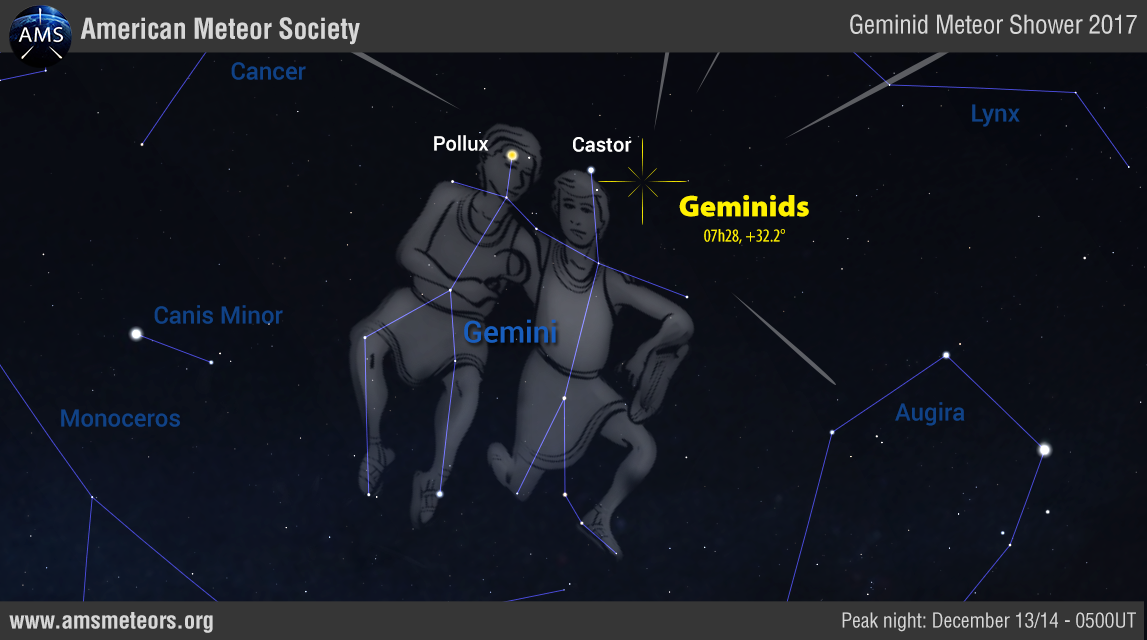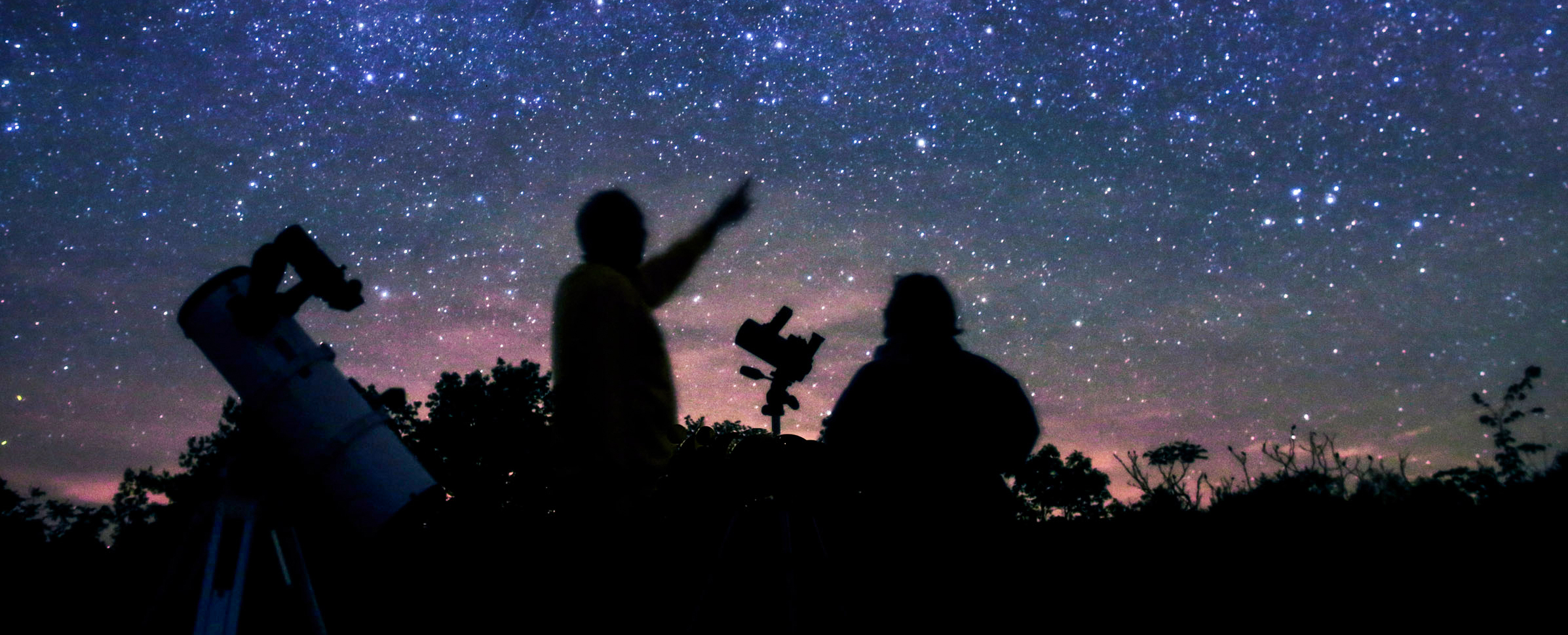The Geminid meteor shower is the favorite of most meteor observers as it usually provides the strongest display of the year. On the peak night (December 13/14) between the hours of 1:00 and 2:00am local standard time (LST), an observer located in mid-northern latitudes under clear skies has the opportunity to view at least 75 Geminid meteors. If you watch from a rural setting far from city lights then your counts could exceed 100. If watching from urban locations you will be limited to around 50 meteors during this period.
The Geminids are one of the few annual meteor showers that are active all night long. The radiant (the area of the sky where the meteors seem to come from) is located near the bright star Castor (alpha Geminorum). This star rises in the northeast near 1700 (5pm) LST as seen from mid-northern latitudes. At that time a few Geminid meteors may be seen streaking slowly upward toward the zenith or shooting parallel to the northern or southeastern horizons. These early Geminids are special as the geometry at this time of night only allows them to skim the top of the atmosphere as seen from your location. Therefore these meteors will last longer and will produced longer streaks in the sky compared to Geminids seen later on in the night. These meteors are referred to as “earthgrazers”. The number of meteors seen at this time will be low, but they will be impressive nonetheless.

As the night progresses the Geminid radiant will rise higher into the sky. The meteors will seem quicker and shorter than those seen at dusk. Their numbers will also increase with each passing hour. The display really kicks into high gear around 2200 (10pm) LST when the radiant reaches the halfway point between the horizon and the zenith (straight up). The radiant will lie highest above the horizon near 0200 LST. This will be the best time to view activity as the radiant will lie overhead and Geminid meteors will be shooting downward in all directions. This is also the only good time to view the Geminids from the southern hemisphere. As seen from latitude 25S, the radiant will lie 1/3 the way up in the northern sky. Viewers there will only be able to see half the activity compared to mid-northern locations. As the morning progresses past 0200 LST the radiant will set into the western sky and rates will fall with each passing hour. As dawn breaks the radiant will lie low in the west.
Your average Geminid meteor is usually as bright as the brighter stars, 2nd or 3rd magnitude. Of course it all depends on the darkness of your sky. Rural observers will be able to see more faint meteors while urban observers are limited to seeing only the brighter ones. Brighter Geminid meteors can produce a color, usually yellow or orange. Fireballs (extremely bright meteors) occur more often during the Geminids and some of these are intensely green or blue. See the featured picture for a great example!
The Geminids are easy to photograph as they are bright and slower moving than most meteors. Any camera that can expose for a minute or longer can capture meteors. Meteors will appear as straight streaks on your pictures. Star trails will be curved. The best area to aim a camera is not straight up but toward the darkest direction available with the camera aimed half-way up in the sky.
People often ask where to look in the sky for meteors. Meteors will appear in all areas of the sky but are best seen away from bright lights that affect your vision. Also, don’t look straight up, rather look roughly half-way up in the sky, high enough to avoid hills or trees that may block your view. Also important is to be comfortable and don’t stand and watch. Sit in a comfortable chair aimed toward your darkest direction. Meteors will appear in bunches so there will be periods of no activity and times of high activity. This is why we suggest watching for as long as possible. This will assure that you will see both slow and strong activity and not just some short period of inactivity. Even under the darkest skies there will be periods as long a 5 minutes when no activity is seen. Just a quickly though you may see 5 meteors in quick succession. It’s also important to remember that you do not need any optical equipment such as a telescope to see meteors. Your unaided eyes offer a wide field of view which is important in catching these swift streaks of light.

Not all the meteors you see will be members of the Geminid shower. There are also other weaker minor showers active this time of year in Taurus (Taurids), Monoceros (Monocerotids), Vela (Puppid-Velids), Hydra (Sigma Hydrids), and Leo Minor (December Leonis Minorids). These meteors will appear differently than the Geminids as they possess different velocities and will have different tracks across the sky.
If the night of December 13/14 is cloudy don’t despair. The Geminids are strong for several nights, most notably during the couple of nights leading up to maximum activity. So if the forecast is cloudy on the night of maximum try to view on the 11/12 and 12/13. One can also view on the 14/15 but rates will have fallen drastically by then.
The Geminids reappear each year during the first half of December when the Earth passes though stony debris left behind by the asteroid known as 3200 Phaethon. This shower and the Quadrantids of January are the only major showers known to be produced by asteroids. Last year’s Geminid maximum display coincided with a full moon which severely limited the number of meteors visible. This year the moon will be a thin waning crescent phase and will rise during the latter part of the night. Therefore it will not be a problem as long as you view before moon rise or look away from the moon once it clears the horizon. So don’t waste this opportunity to see an impressive display of natural fireworks!
 American Meteor Society
American Meteor Society
Thanks Robert, this will be my first attempt at meteor shower photography. So, your article was of particular interest. I have a camera with an intervelometer which should allow me to take hundreds images and capture the Geminids. I suspect that the same set of images can be used for star trails. Based on your recommendation that the 2 evenings leading up to 13/14 are good also, I now plan on at least 1 night of testing.
Off to a great start to tonight’s grand finale.
Early night viewing data from Cottonwood, Calif: (-122.12W, 40.23N) under ideal viewing conditions:
12/11/17 21:00-23:00
# Geminids: 28
# sporadics 8
# fireballs: 3
# colors 1 yellow. All others white.
12/12/17 21:00-23:00
# Geminids: 63
# sporadics 6
# fireballs 1
# colors 1 red (sporadic with smoke trail)
Here are my totals for last night’s grand finale, here in Cottonwood, California. A really superb show.
Note I shifted my 2 hr. viewing block up by 1/2 hr. past the previous two nights.
# Geminids: 201
# sporadics 19
# fireballs: 4, with one bolide visible for over 2 seconds producing twin bursts as it disintegrated along with a long residual smoke trail. The bolide was observed very low in the SE sky, and I cannot confirm it was actually a Geminids due to the large visual distance away from the radiant. Overall I’d say the characteristics suggest a sporadic, but a Geminid can’t be ruled out.
# colors 3 blue, 1 red (sporadic). All others white.
Was on road at 4:05am on 12/13/17. Driving down Nova Rd., St.Cloud, Fl., saw 4 very distinctive falling bright lights, like falling stars? We’re these meteors? Most beautiful site, wished I could have captured by camera.